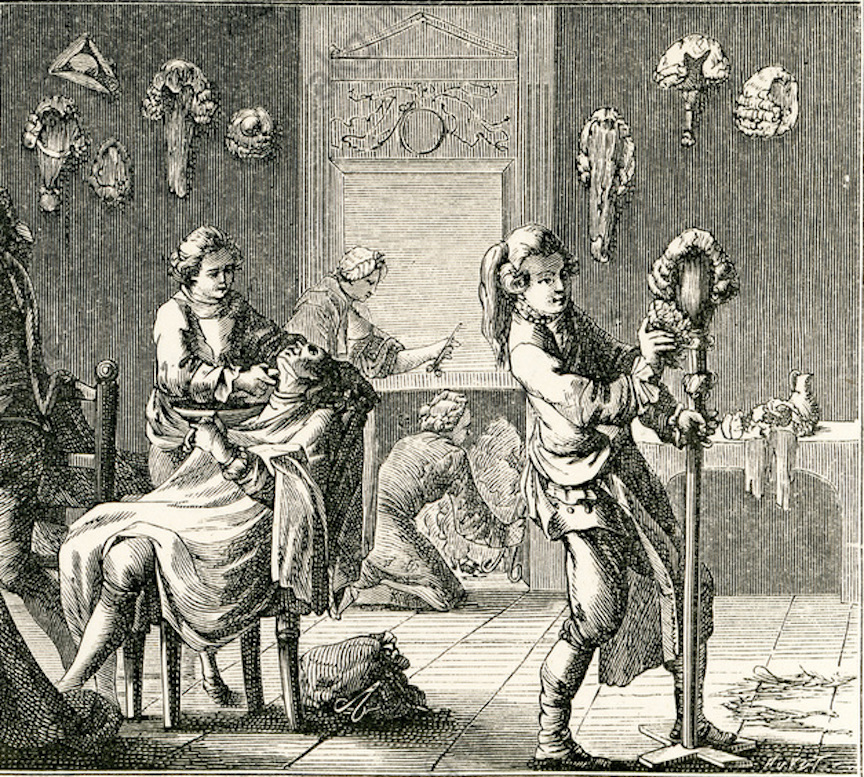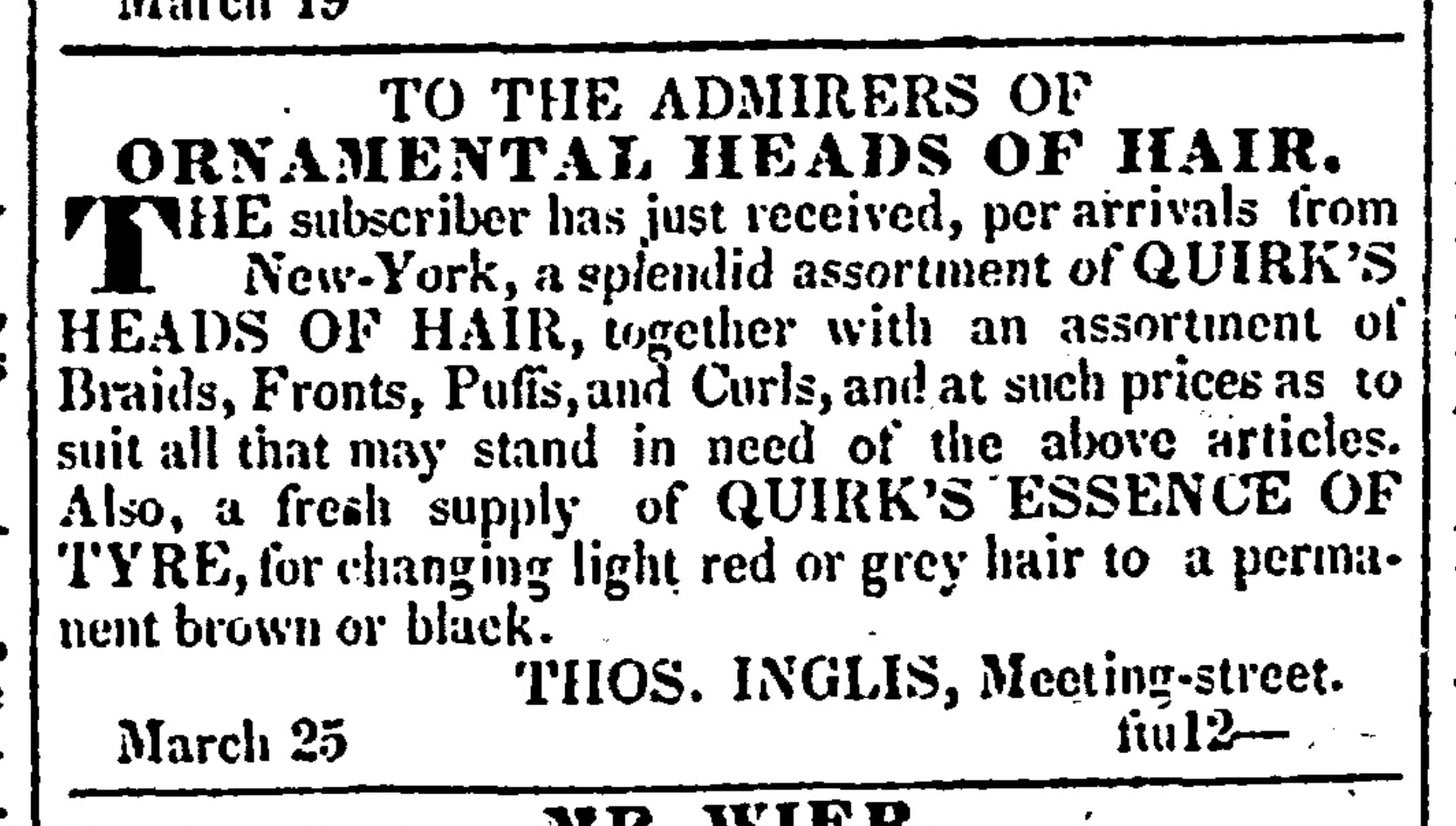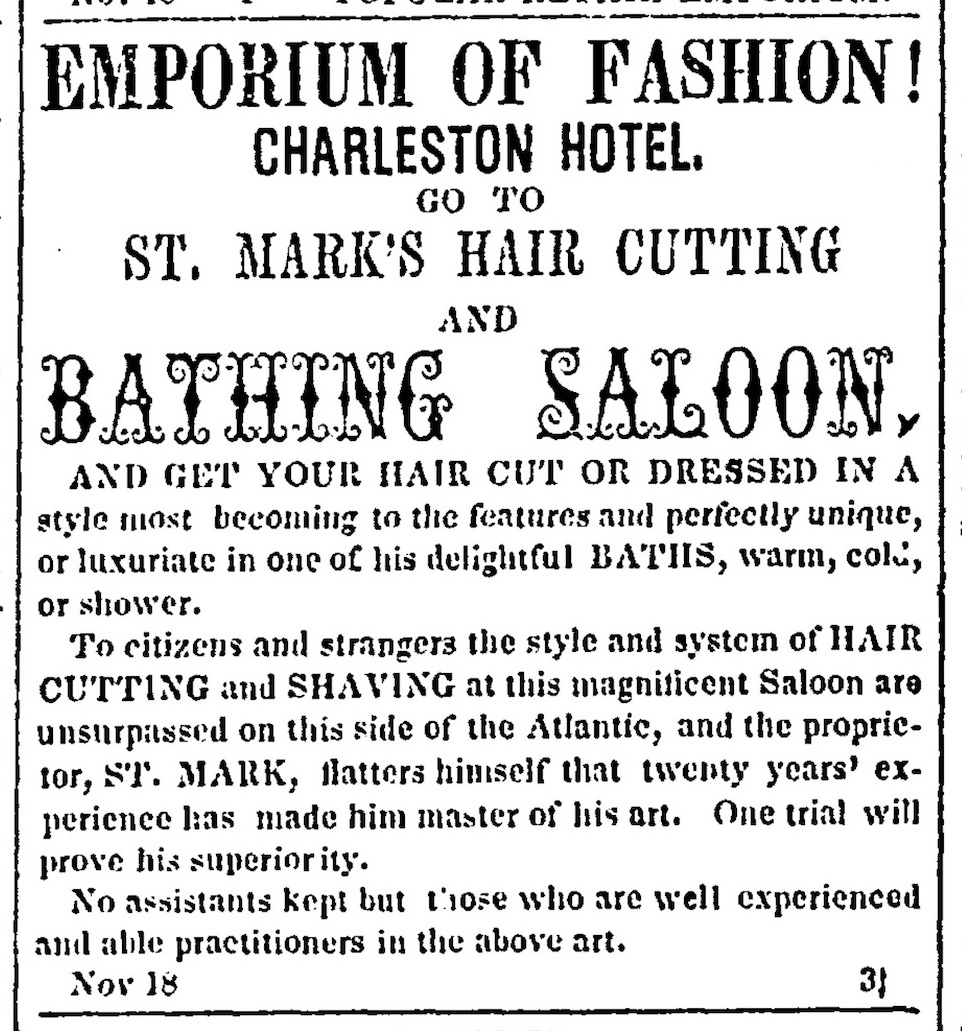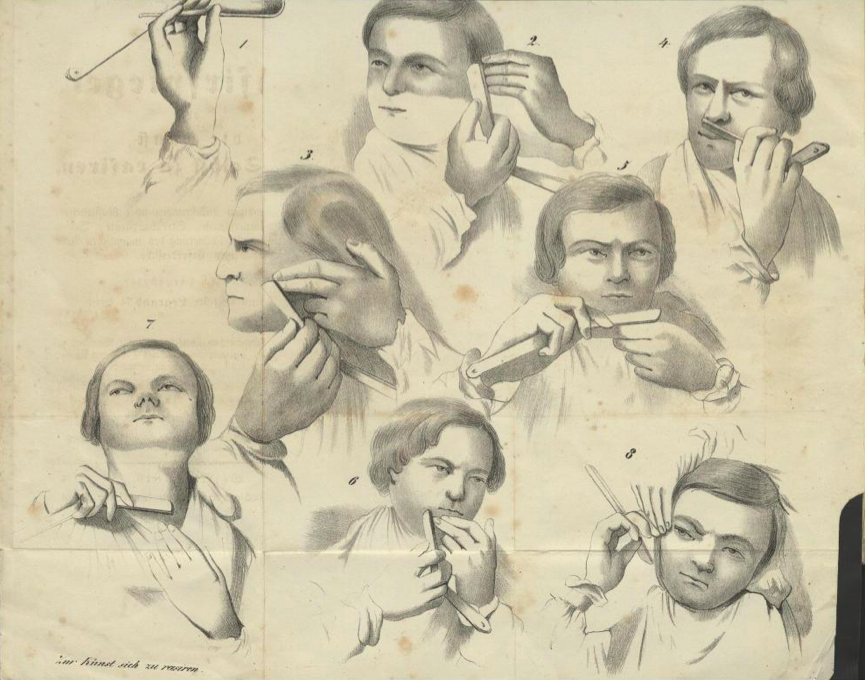
Three centuries ago, enslaved men of African descent in the Lowcountry of South Carolina routinely shaved and coiffed their White owners. As the population of “free persons of color” swelled in late-eighteenth-century Charleston, Black men with hair-dressing skills opened segregated barber shops catering primarily to White customers. Generations of Black barbers dominated the city’s tonsorial trade into the middle of the twentieth century, when the politics of desegregation introduced an ironic shift. The familiar Black barber shops in our community today represent the continuation of a tangled colonial legacy of shared history.
Before we dive into today’s program, I’d like to mention two caveats about the topic at hand. First, We’re going to focus on the forgotten tradition of Black barbers cutting, shaving, and dressing the hairs of White customers. Details relating to African-American hair styling in South Carolina prior to the demise of slavery in 1865 are far more obscure than those relating to the White population. Few surviving documents address this topic. In general, however, we can conclude that enslaved men and women in early South Carolina “dressed” each other’s hair, and likely followed tonsorial traditions inherited from Africa. Among the thousands of runaway slave advertisements published in local newspapers between 1732 and 1865, for example, one can find numerous references to bushy hair, wooly hair, wavy hair, combed hair, hair in plaits, hair in queues, straight hair, divided hair, spiky hair, and so on. Furthermore, archaeological evidence suggests that enslaved people transported to this area and their descendants might have decorated their hair with beads and small shells, like their contemporaries in Africa, the Caribbean, and South America.
Secondly, today’s program focuses on male barbers or “hair dressers,” as they were once commonly called, who practiced their arts on the heads of other men. African-American hairstylists who focused on female hair certainly existed in eighteenth and nineteenth century Charleston, but they generally worked within their own household or visited the private homes of their clients. Women of previous centuries trimmed their hair infrequently, and generally relied on female family members or enslaved servants to dress their hair. Commercial hair salons catering to female clients proliferated during the second half of the twentieth century, but that industry barely existed here prior to the 1950s.

Professional barbers have existed in various cultures for many centuries, of course, but hair-trimming and styling was not always their focus. Most men and boys in the distant past wore their hair much longer than the average male of the twenty-first century. Early barbers around the world, therefore, focused on shaving faces and heads. Wealthy men (and women) in different cultures frequently had their heads shaved for hygienic reasons and wore elaborate wigs in public. Less affluent people, in contrast, “wore their own hair,” as it was called in the seventeenth and eighteenth centuries, when lice was a more common part of domestic life.
Barbering in Europe, like other trades, became more specialized and professionalized during the course of the seventeenth and eighteenth centuries, as urban communities expanded and developed the proto-modern economy that we take for granted today. At the same time, the technology of forging and polishing blades improved to the extent that workshops in places like Sheffield, England, could produce folding straight razors, suitable for face shaving, in large quantities for retail sale. The proliferation of high-quality shaving razors in early-eighteenth-century Europe made both face shaving and head shaving more popular, and a sign of economic status. A man who could afford to pay a barber periodically to shave his face and head wore a wig in public according to the latest fashion, his smooth skin providing visual signs of his pretentions to the elevated rank of “gentleman.” In the privacy of their own homes, affluent men and women replaced their wigs with fancy silk caps that again signaled their status above the common folk who “wore their own hair.”
There were White barbers in early Charleston, during the late seventeenth and early eighteenth centuries, but never more than a few at any one time. By the 1730s, if not much earlier, we know that White European barbers active in South Carolina were teaching their skills to enslaved men of African descent. In the autumn of 1734, for example, Daniel Pepper, who lived on the upper reaches of the Ashley River, advertised the sale of “a Negro fellow who has serv’d his time [as an apprentice] to a barber, and is a good cook.”[1] Similar sale advertisement published during the colonial era demonstrate that the number of enslaved barbers proliferated while the population of resident White barbers remained small.
The transference of barbering skills to the enslaved population of urban Charleston was part of an educational trend that commenced in the earliest days of the colony, when the law of early South Carolina defined enslaved people as chattel property. To augment the value and productivity of such property, many slave owners apprenticed teenage boys of African descent to adult businessmen to learn specific skills. While the majority of the enslaved people within South Carolina labored among the fields of rural plantations, the capital town included nearly equal numbers of free and unfree residents who provided a wide variety of services. Enslaved Charlestonians worked as porters (day laborers), attended customers in shops and taverns, practiced skilled trades such as carpenters, blacksmiths, brick-masons, butchers, and tailors, and fulfilled a variety of traditional roles as domestic servants. Whereas the gentlemen and ladies of contemporary Britain were accustomed to being waited on by liveried White valets and maids, for example, South Carolina’s gentry were attended by a train of enslaved Black servants dressed like their equivalents back “home” in Europe.
This is where the story gets very interesting. Enslaved male valets and enslaved female maids found themselves in unique positions—compared to their enslaved brothers and sisters employed elsewhere—to develop important degrees of intimacy with the men and women they served. Enslaved valets and maids helped their owners dress and undress, attended them at social events both public and private, nursed them when they were ill, and engaged in personal conversations behind closed doors that bred familiarity and trust. In this context, a White slave owner might hand a straight razor to a trusted enslaved man of African descent and invite him to apply the lethal blade to his hairy white neck.
By the middle of the eighteenth century, the use of enslaved barbers in South Carolina was so ubiquitous that it was protected by law. In the spring of 1750, the provincial legislature ratified a statute designed to prevent competition between White and Black artisans. To ensure that White tradesmen would flourish within a community increasingly dominated by enslaved laborers, the government declared it henceforth illegal for enslaved boys and men to learn or practice any skilled trade or handicraft, with two important exceptions. First, the legislature permitted every White artisan to teach his own trade to his own slaves so they could augment their owner’s income. Second, the law specifically did not hinder any person “from putting his slave apprentice to learn the trade of a barber to be employed for such persons own use.”[2] In other words, the government recognized that barbering skills were important to the people of South Carolina, and slave owners had a right to send enslaved boys and men beyond their homes to acquire barber training that they could bring back to the families of their respective owners.
The 1750 law enacted to eradicate competition between White and Black artisans in South Carolina was a complete failure. In the year 1785, for example, a new resident of Charleston, Timothy Ford, observed that nearly every White tradesman in the city owned a number of enslaved men who performed the trade work for him. “In fact,” Ford wrote in his diary, “many of the mechanics [that is, skilled artisans] bear nothing more of their trade than the name.” Curiously, he noted that White hair dressers were especially guilty of this practice. The barbers of urban Charleston, said Timothy Ford in 1785, “are supported in idleness & ease by their negroes who do the business.”[3]
The extant Charleston newspapers from the second half of the eighteenth century provide ample evidence of the proliferation of enslaved barbers of African descent. The 1756 estate of John Miller of Cainhoy, for example, included “a very good barber, by name King, who lately lived with Mr. Peter Butler [a white barber] in Charles-Town.”[4] In 1760, Alexander Gordon advertised for sale “a stout able handy young healthy negro fellow . . . very capable either to go in a boat, work in a field, or wait on a gentleman as a footman, having learned the barber’s business.”[5] The estate of Robert Fairweather in June 1763 included six enslaved men, including “Jack and Peter, both good barbers; Jamie, a boy, has been above a year at the said trade, can dress a wig, is smart and fit to wait on a gentleman.”[6] That same month, William Hopton advertised for sale “a healthy sensible mulatto fellow . . . a barber by trade, having lived about 5 years with [barber] Mr. Charles You, is very fit for that business, and to wait in a house, or on a gentleman.”[7] John Bothwell advertised in 1767 for a runaway “negro fellow named Peter, by trade a barber, well known in and about Charlestown.”[8]

The presence of numerous enslaved hair-dressers in eighteenth century Charleston indicates that at least some White barbers of European descent were willing to work with and train teenagers of African descent over a period of some months and years. A White barber named Clark provided useful evidence of this practice in the autumn of 1774. Having just arrived in Charleston, Mr. Clark advertised that he had taken a house in Tradd Street and made perukes and wigs according to the latest fashions. More importantly, he informed the public that “any gentlemen, in town or country, may have their Negro boys instructed in the art of hair-dressing on the most reasonable terms.”[12]
On the eve of the American Revolution, the hair-dressing population of urban Charleston included a handful of professional White barbers, scores of enslaved men and boys trained in the arts of shaving and dressing hair, and perhaps a few free persons of color who made a living as barbers. The number of free people of color in urban Charleston grew dramatically in the decades after the American Revolution, from a few dozen people around the year 1770 to a few hundred around the turn of the nineteenth century. Extant documentary records of enslaved South Carolinians who gained their freedom during this era demonstrate that the most likely candidates for manumission were those who had some degree of sustained personal contact with the individual who legally owned their respective bodies. Through such close contact, many slave owners learned to recognize the humanity of their enslaved valets, maids, and nurses. It’s no surprise, therefore, that barbers formed a significant proportion of the free “colored” people of Antebellum Charleston.
Enslaved barbers who gained their freedom around the turn of the nineteenth century needed to earn a living, of course, and market forces shaped the trajectory of their careers. Operating within a racially-segregated, highly-prejudiced community, free men of color opened barber shops catering exclusively to White male customers. They might shave and dress the hair of enslaved friends and family after hours, but White men formed the bread-and-butter, so to speak, of the city’s barbering trade. As White barbers had done in the eighteenth century, free Black barbers augmented their income by teaching their skills to teenage apprentices of African descent, both enslaved and free. With each passing generation, the number of Black barbers in Charleston and across South Carolina continued to increase throughout the nineteenth century.
The task of recovering biographical information about enslaved barbers working in eighteenth-century Charleston is frustrated by a paucity of extant documents. In contrast, the survival of daily newspapers, probate records, and other government document renders it much easier (relatively speaking) to learn about the lives and careers of free Black barbers operating in nineteenth-century Charleston. Among the surviving capitation tax records, for example, one can find the names and addresses of dozens of barbers active in the city between the 1810s and 1864. Similarly, the published city directories of residents and business operating in the city began listing Black barbers in the 1820s, a tradition that continues to the present.
Some of the early African-American barbers in urban Charleston rented space within existing storefronts, while other acquired sufficient wealth to purchase their own business space and rent chairs to other barbers. Moses Brown, for example, was an enslaved mulatto barber before the American Revolution who earned enough money to purchase his freedom in 1789. He rented a shop in Elliott Street for many years before his death in 1819, and passed his skills on to the next generation through numerous apprentices. Moses’s son, Peter Brown, was one of several slave-owning barbers working in Antebellum Charleston. Following Peter’s death in 1865, his numerous students carried on the trade into the Reconstruction Era.

According to the Federal census of 1850, there were two dozen free men of color working as professional barbers in the city of Charleston, seven of whom owned enslaved men who augmented their business income. Among these was Francis St. Mark, who operated a fashionable “hair cutting and bathing saloon” within the prestigious Charleston Hotel on Meeting Street. Mr. St. Mark’s newspaper advertisements, like those of his predecessor, Thomas Inglis, appealed to a white clientele conscious of following the latest trends in the tonsorial arts.
Charleston was not the only city in nineteenth-century America to host a community of professional Black barbers, of course. Greater numbers of them could be found in larger cities like Philadelphia and New York, where they formed a relatively smaller proportion of the barbering business. While men like the Francis brothers, Peter Brown, Francis St. Mark, and other free men of color continued to dominate Charleston’s barbering business in the 1850s, the number of Black barbers in Northern cities began to decline rapidly. Around that time, Frederick Douglass famously remarked that “a few years ago . . . the white barber would have been a curiosity—now their poles stand on every street” in the urban centers of the Northern states. In Charleston, however, their numbers remained strong. In the Federal census of 1860, eighty percent (80%) of the barbers operating commercially in the Palmetto City were African-American.[14]
After the Civil War and the demise of slavery, the barbering business in South Carolina remained as segregated as it had been for generations. In the spring of 1870, however, a number of Black men in Charleston visited restaurants, saloons, and barber shops that traditionally catered only to White customers and demanded service. A new Federal civil rights bill had just come into effect to ensure equal access to such facilities, and Black customers in the Palmetto City sought to test the enforcement of the law. The proprietors at many facilities, including barber shops, rebuked the Black civil rights advocates and refused to serve them. “The barbers were colored men,” observed the Charleston Daily News, “and they protested vehemently against the conduct of these men, asserting that they would ruin the business of all the colored men if they continued such a course of action. One barber became indignant at the impudence of a colored man who would sit in one of the shaving chairs and demand to be shaved, and thinking the bill aforesaid gave him some rights also, severely punched the head of the offending individual.” In the end, the Black activists were forced to retreat in order preserve the status quo. As a newspaper editor remarked in 1870, the Federal government’s social equality policy was bad for business; White men would rather stay at home than “to be the customer of a barber-shop whose towels and brushes are used for white and black alike.”[15]
In 1900, Black barbers still formed ninety-seven percent (97%) of the commercial hair-cutting work force in Charleston, and the industry was still segregated along traditional lines. While some of the Black barber shops operating here around the turn of the twentieth century served customers of African descent, many continued to cater exclusively to White men, as their predecessors had done a century before. During the bloody Charleston Riot of 1919, for example, White men trashed a barbershop at 305 King Street known as “Fridie’s Central Shaving Parlor.” According to a local newspaper report at the time, William Fridie’s establishment was “run by negroes for white men.”[16]

Today’s program represents a brief overview of a deep and complicated topic. One could fill an entire book with the details of African-American barbering in nineteenth-century Charleston, focusing on the stylists, customers, venues, economics, and, of course, the hairstyles, techniques, and equipment of that era.[17] Despite the brevity of today’s survey, I feel confident that a longer exploration of this topic would follow a similar theme: The history of barbering in our community, like so many interesting topics, is not simply Black or White. It’s a shared phenomenon rooted in the interaction of people from disparate backgrounds who led very different lives. By reaching back in time to view the remnants of our distant past, we can better appreciate the tangled roots underpinning the Black barbershops that thrive in our community today.
[1] South Carolina Gazette [hereafter SCG], 5–12 October 1734, page 4.
[2] See section 23 of Act No. 775, “An Act for keeping the Streets in Charles Town clean, and establishing such other regulations for the security Health and Convenience of the Inhabitants of the said Town as are therein mentioned, and for establishing a new Market in the said Town,” ratified on 31 May 1750, was not included in the published Statutes at Large of South Carolina, but the engrossed copy is found at the South Carolina Department of Archives and History. An abstract of this lengthy act appears as a two-page supplement to SCG, 2–9 July 1750, No. 843.
[3] Joseph Walker Barnwell, ed. “Diary of Timothy Ford, 1785–1786,” South Carolina Historical Magazine 13 (1912): 142 (of 132–47).
[4] SCG, 4 November 1756, supplement, page 2. Elizabeth Butler advertised for the estate of Peter Butler, barber, in SCGCJ, 10 November 1767, page 3.
[5] SCG, 12–19 July 1760, page 4.
[6] SCG, 4–11 June 1763, page 2.
[7] SCG, 4–11 June 1763, page 1.
[8] SCAGG, 1–8 May 1767, page 3.
[9] SCG, 4 April 1771, page 3.
[10] SCGCJ, 31 May 1774, page 3.
[11] South Carolina American General Gazette, 12–19 August 1774, page 1; SCAGG, 11–18 November 1774, page 6.
[12] SCAGG, 30 September –7 October 1774, page 2.
[13] Larry Koger, Black Slaveowners: Free Black Slave Masters in South Carolina, 1790–1860 (Jefferson, N.C.: McFarland, 1985), 151–53.
[14] Bristol, Knights of the Razor, 103–4.
[15] Charleston Daily News, 4 March 1870, page 1, “Civil Rights”; 11 January 1870, “Social Equality.”
[16] Bristol, Knights of the Razor, 160; Charleston News and Courier, 11 May 1919; page 1, continued on page 3.
[17] To learn more about the general history of Black barbers in the United States, see Douglas W. Bristol Jr., Knights of the Razor: Black Barbers in Slavery and Freedom (Baltimore: Johns Hopkins University Press, 2009), and Quincy T. Mills, Cutting Along the Color Line: Black Barbers and Barber Shops in America (Philadelphia: University of Pennsylvania Press, 2013).
NEXT: The Voice of the 'Black Swan' in 1873 Charleston
PREVIOUSLY: South Carolina's Capitation Tax on Free People of Color, 1756–1864
See more from Charleston Time Machine
